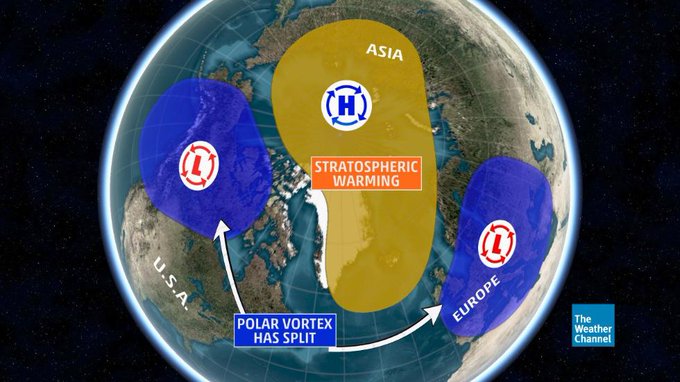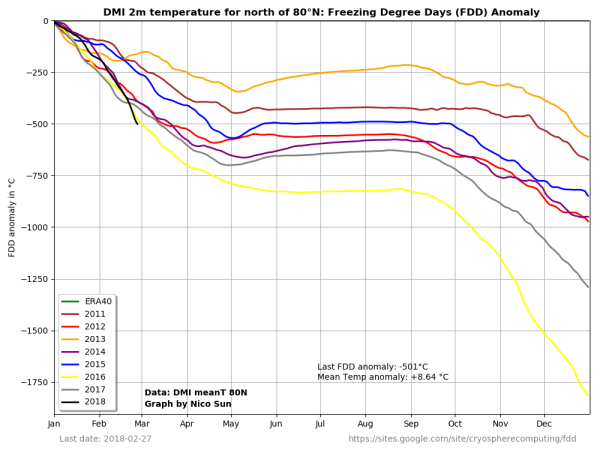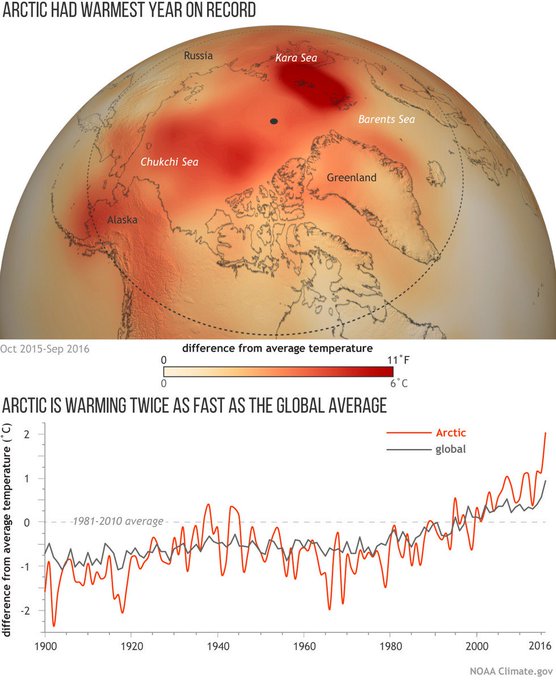Sudden
Stratospheric Warming and Polar Amplification: How Climate Change
Interacts With the Polar Vortex
28
February, 2018
Over
the past few years, the term Polar
Vortex has
dominated the broadcast weather media — gaining recent notoriety
due to increasingly extreme weather events associated with a number
of disruptions to Arctic atmospheric circulation patterns. In short,
this swirl of cold air over the furthest north regions is being
intensely disrupted by warm air invasions — both at the surface and
in the upper levels of the atmosphere. A subject that we’ll explore
further as part of this analysis.
The #PolarVortex has split. Here's what that means for you: http://wxch.nl/2o0ei6u
Take the
recent extreme February warming at the North Pole in which
temperatures there rose to above freezing even
as a major cold snap slammed into Europe this week. We’ve seen such
varied headlines as Yes
the North Pole is Warmer than Europe Right Now and Arctic
Warm Event Stuns Scientists.
When
it’s warmer at the pole than in Europe, it’s a sign that the
weather is clearly out of whack. Especially when temperatures in a
region spanning tens of thousands of square miles over the
Arctic rocket
to between 40 and 63 degrees Fahrenheit above normal.
Scientists are notably concerned. Dr.
Michael Mann,
one of the world’s foremost experts on climate change
characterized the
polar warming event as:
…an anomaly among anomalies. It is far enough outside the historical range that it is worrying — it is a suggestion that there are further surprises in store as we continue to poke the angry beast that is our climate.
But what’s driving all
this? Dr. Mann gives us a bit of a hint by describing our climate as
an angry beast that’s being poked.
(Polar
Amplification writ
large. The entire region of the Arctic above the 80 degree North
Latitude line has been 8.64 degrees Celsius warmer than normal for
all of 2018 thus far. This is an extraordinary departure for a region
that plays a critical role in how the Earth’s climate system
functions. Image source: DMI.)
Perhaps
another way to say it is that it’s a warming atmosphere that’s
prodding the
Jet Stream to take a chunk out of the Polar Vortex.
How
might this work?
First, surface warming in
the Arctic caused by increased radiative forcing from rising
greenhouse gas levels and by follow-on reductions of Arctic sea ice
and snow result in less temperature difference between the Pole and
the Equator. This surface warming translates into higher levels of
the atmosphere through convection.
Temperature
difference is what drives the upper level winds.
So a lower difference in temperature causes these winds to slow. When
the Jet Stream winds slow, they tend to meander — forming large
ridges and deep troughs. The elongated ridges and troughs eventually
break like waves — pushing against the circulation of the Polar
Vortex.
(NOAA
graphic shows
how a weak jet stream results in changes in atmospheric circulation
and increased disruption of the Polar Vortex.)
When this happens, the
speed of the winds that make up the Polar Vortex slow down and
sometimes reverse. This results in the collapse of the column of
upper level air held aloft by the Vortex’s winds. When the air
collapses, it compresses, causing the stratosphere to warm. This
falling column of warm air then can end up acting like an atmospheric
wedge — driving the Polar Vortex apart and causing it to split.
The split then tends to
generate smaller funnels that capture polar air and pull it south.
Beneath the funnels, it can be quite cold as Arctic air invades
places like North America or the UK (as happened this week). But at
the Pole, where the cold air should typically reside, it warms up
enormously.
Global Temperature Anomalies Feb 28:
1. Arctic much warmer than normal at +4.4 C.
2. Polar vortex collapse drives cold air S into Europe.
3. Globe warmer than normal at +0.7 C.
4. All major climate zones except Antarctica warmer than 30 year average.
5. Note Africa - S. Asia. pic.twitter.com/W8Mqsi035N
Arctic warming twice as fast as rest of world with noted warming acceleration since 2000. Data source: NOAA. pic.twitter.com/ckkYhgdikE
That’s
how, under a regime of human-forced climate change, you can end up
with periods where temperatures are warmer at the Pole than they are
in Europe.
It’s
worth noting that Polar Vortex collapse events did occur in the past.
But not in such a way that generated the kinds of historically
extreme Arctic temperatures we see today. The primary driver for the
recently increased extremity of weather driven by Polar Vortex
collapse events being human-caused climate change, Polar
Amplification, and related influences on the Jet Stream.







No comments:
Post a Comment
Note: only a member of this blog may post a comment.